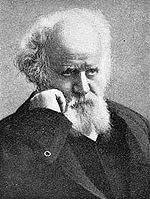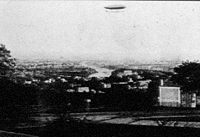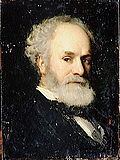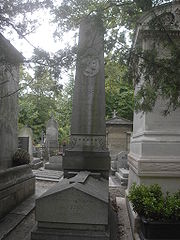
Pierre Jules César Janssen
Encyclopedia



Astronomy
Astronomy is a natural science that deals with the study of celestial objects and phenomena that originate outside the atmosphere of Earth...
who, along with the English scientist Joseph Norman Lockyer
Joseph Norman Lockyer
Sir Joseph Norman Lockyer, FRS , known simply as Norman Lockyer, was an English scientist and astronomer. Along with the French scientist Pierre Janssen he is credited with discovering the gas helium...
, is credited with discovering the gas helium
Helium
Helium is the chemical element with atomic number 2 and an atomic weight of 4.002602, which is represented by the symbol He. It is a colorless, odorless, tasteless, non-toxic, inert, monatomic gas that heads the noble gas group in the periodic table...
.
Life, work, and interests
Janssen was born in Paris and studied mathematicsMathematics
Mathematics is the study of quantity, space, structure, and change. Mathematicians seek out patterns and formulate new conjectures. Mathematicians resolve the truth or falsity of conjectures by mathematical proofs, which are arguments sufficient to convince other mathematicians of their validity...
and physics
Physics
Physics is a natural science that involves the study of matter and its motion through spacetime, along with related concepts such as energy and force. More broadly, it is the general analysis of nature, conducted in order to understand how the universe behaves.Physics is one of the oldest academic...
at the faculty of sciences. He taught at the lycée Charlemagne in 1853, and in the school of architecture
Architecture
Architecture is both the process and product of planning, designing and construction. Architectural works, in the material form of buildings, are often perceived as cultural and political symbols and as works of art...
1865 – 1871, but his energies were mainly devoted to various scientific missions entrusted to him. Thus in 1857 he went to Peru in order to determine the magnetic equator
Equator
An equator is the intersection of a sphere's surface with the plane perpendicular to the sphere's axis of rotation and containing the sphere's center of mass....
; in 1861 – 1862 and 1864, he studied telluric absorption in the solar spectrum in Italy and Switzerland; in 1867 he carried out optical and magnetic experiments at the Azores; he successfully observed both transits of Venus
Transit of Venus
A transit of Venus across the Sun takes place when the planet Venus passes directly between the Sun and Earth, becoming visible against the solar disk. During a transit, Venus can be seen from Earth as a small black disk moving across the face of the Sun...
, that of 1874 in Japan, that of 1882 at Oran
Oran
Oran is a major city on the northwestern Mediterranean coast of Algeria, and the second largest city of the country.It is the capital of the Oran Province . The city has a population of 759,645 , while the metropolitan area has a population of approximately 1,500,000, making it the second largest...
in Algeria; and he took part in a long series of solar eclipse-expeditions, e.g. to Trani (1867), Guntur
Guntur
Guntur , is a city and a municipal corporation in the Indian state of Andhra Pradesh, located to the north and west of the Bay of Bengal. It is approximately to the south of the national capital, New Delhi and south east of state capital, Hyderabad. Guntur is the fourth largest city in Andhra...
(1868), Algiers
Algiers
' is the capital and largest city of Algeria. According to the 1998 census, the population of the city proper was 1,519,570 and that of the urban agglomeration was 2,135,630. In 2009, the population was about 3,500,000...
(1870), Siam (1875), the Caroline Islands (1883), and to Alcosebre in Spain (1905). To see the eclipse of 1870 he escaped from besieged Paris in a balloon (that eclipse was obscured by cloud cover, however).
Discovery of helium
In 1868 Janssen discovered how to observe solar prominenceSolar prominence
A prominence is a large, bright feature extending outward from the Sun's surface, often in a loop shape. Prominences are anchored to the Sun's surface in the photosphere, and extend outwards into the Sun's corona...
s without an eclipse
Eclipse
An eclipse is an astronomical event that occurs when an astronomical object is temporarily obscured, either by passing into the shadow of another body or by having another body pass between it and the viewer...
. While observing the solar eclipse of August 18, 1868
Solar eclipse of August 18, 1868
A total solar eclipse occurred on August 18, 1868. - Observations :Captain Bullock observed from the Celebes sea, sketching the appearance of the corona, while Gustav Fritsch accompanied an expedition to Aden. -Discovery of helium:...
at Guntur
Guntur
Guntur , is a city and a municipal corporation in the Indian state of Andhra Pradesh, located to the north and west of the Bay of Bengal. It is approximately to the south of the national capital, New Delhi and south east of state capital, Hyderabad. Guntur is the fourth largest city in Andhra...
, in Andhra Pradesh
Andhra Pradesh
Andhra Pradesh , is one of the 28 states of India, situated on the southeastern coast of India. It is India's fourth largest state by area and fifth largest by population. Its capital and largest city by population is Hyderabad.The total GDP of Andhra Pradesh is $100 billion and is ranked third...
, British India, he noticed a bright yellow line with a wavelength
Wavelength
In physics, the wavelength of a sinusoidal wave is the spatial period of the wave—the distance over which the wave's shape repeats.It is usually determined by considering the distance between consecutive corresponding points of the same phase, such as crests, troughs, or zero crossings, and is a...
of 587.49 nm in the spectrum
Spectroscopy
Spectroscopy is the study of the interaction between matter and radiated energy. Historically, spectroscopy originated through the study of visible light dispersed according to its wavelength, e.g., by a prism. Later the concept was expanded greatly to comprise any interaction with radiative...
of the chromosphere
Chromosphere
The chromosphere is a thin layer of the Sun's atmosphere just above the photosphere, roughly 2,000 kilometers deep....
of the Sun. This was the first observation of this particular spectral line, and one possible source for it was an element not yet discovered on the earth. Janssen was at first ridiculed since no element had ever been detected in space before being found on Earth.
On 20 October of the same year, Joseph Norman Lockyer
Joseph Norman Lockyer
Sir Joseph Norman Lockyer, FRS , known simply as Norman Lockyer, was an English scientist and astronomer. Along with the French scientist Pierre Janssen he is credited with discovering the gas helium...
also observed the same yellow line in the solar spectrum and concluded that it was caused by an unknown element, after unsuccessfully testing to see if it were some new type of hydrogen. This was the first time a chemical element was discovered on an extraterrestrial body before being found on the earth. Lockyer and the English chemist Edward Frankland
Edward Frankland
Sir Edward Frankland, KCB, FRS was a chemist, one of the foremost of his day. He was an expert in water quality and analysis, and originated the concept of combining power, or valence, in chemistry. He was also one of the originators of organometallic chemistry.-Biography:Edward Frankland was born...
named the element with the Greek word for the Sun, ἥλιος (helios).
Observatories

Sun
The Sun is the star at the center of the Solar System. It is almost perfectly spherical and consists of hot plasma interwoven with magnetic fields...
contains oxygen
Oxygen
Oxygen is the element with atomic number 8 and represented by the symbol O. Its name derives from the Greek roots ὀξύς and -γενής , because at the time of naming, it was mistakenly thought that all acids required oxygen in their composition...
or not. An indispensable preliminary was the virtual elimination of oxygen-absorption in the Earth's atmosphere
Earth's atmosphere
The atmosphere of Earth is a layer of gases surrounding the planet Earth that is retained by Earth's gravity. The atmosphere protects life on Earth by absorbing ultraviolet solar radiation, warming the surface through heat retention , and reducing temperature extremes between day and night...
, and his bold project of establishing an observatory on the top of Mont Blanc
Mont Blanc
Mont Blanc or Monte Bianco , meaning "White Mountain", is the highest mountain in the Alps, Western Europe and the European Union. It rises above sea level and is ranked 11th in the world in topographic prominence...
was prompted by a perception of the advantages to be gained by reducing the thickness of air through which observations have to be made. This observatory, the foundations of which were fixed in the snow that appears to cover the summit to a depth of ten metres, was built in September 1893, and Janssen, in spite of his sixty-nine years, made the ascent and spent four days taking observations.
In 1875, Janssen was appointed director of the new astrophysical observatory established by the French government at Meudon
Meudon
Meudon is a municipality in the southwestern suburbs of Paris, France. It is in the département of Hauts-de-Seine. It is located from the center of Paris.-Geography:...
, and set on foot there in 1876 the remarkable series of solar photographs collected in his great Atlas de photographies solaires (1904). The first volume of the Annales de l'observatoire de Meudon was published by him in 1896.
Death, honors, and legacy
Janssen died at Meudon on 23 December 1907 and was buried at Père Lachaise CemeteryPère Lachaise Cemetery
Père Lachaise Cemetery is the largest cemetery in the city of Paris, France , though there are larger cemeteries in the city's suburbs.Père Lachaise is in the 20th arrondissement, and is reputed to be the world's most-visited cemetery, attracting hundreds of thousands of visitors annually to the...
in Paris. During his life he was made a Knight of the Legion of Honor and a Foreign Member of the Royal Society of London. Crater
Impact crater
In the broadest sense, the term impact crater can be applied to any depression, natural or manmade, resulting from the high velocity impact of a projectile with a larger body...
s on both Mars and the moon are named in his honor.
In popular media
In the SimpsonsThe Simpsons
The Simpsons is an American animated sitcom created by Matt Groening for the Fox Broadcasting Company. The series is a satirical parody of a middle class American lifestyle epitomized by its family of the same name, which consists of Homer, Marge, Bart, Lisa and Maggie...
episode Bart's Comet
Bart's Comet
"Bart's Comet" is the 14th episode of The Simpsons sixth season. The episode originally aired on the Fox network in the United States on February 5, 1995. In the episode, Bart Simpson accidentally discovers a comet, which is heading towards Springfield...
after Bart Simpson
Bart Simpson
Bartholomew JoJo "Bart" Simpson is a fictional main character in the animated television series The Simpsons and part of the Simpson family. He is voiced by actress Nancy Cartwright and first appeared on television in The Tracey Ullman Show short "Good Night" on April 19, 1987...
sabotages Principal Seymour Skinner
Seymour Skinner
Principal W. Seymour Skinner is a fictional character in the American animated sitcom The Simpsons. He is voiced by Harry Shearer. Born in Capitol City, he is the principal of Springfield Elementary School...
's weather balloon
Weather balloon
A weather or sounding balloon is a balloon which carries instruments aloft to send back information on atmospheric pressure, temperature, humidity and wind speed by means of a small, expendable measuring device called a radiosonde...
, Principal Skinner says, "Curse the man who invented helium! Curse Pierre-Jules-Cesar Janssen!"
Further reading
, from Monthly Notices of the Royal Astronomical Society, 1908, vol. 68, pp. 245–249- Obituary, from Popular Astronomy, 1908, vol. 16, pp. 72–74
- Obituary, from Astronomische Nachrichten, 1908, vol. 177, p. 63 (in French)
- Obituary, from The Astrophysical Journal, 1908, vol. 28, pp. 89–99 (in French)
- 1911 Encyclopædia Britannica Eleventh Edition, entry for Janssen
- Janssen statue, description and black-and-white picture from The Observatory, 1922, vol. 45, pp. 175–176
- Brief biography, from the High Altitude Observatory at Boulder, Colorado
- Janssen's chronophotography

